What’s new?
Hitting the sweet spot is of paramount importance. This is irrespective of the game you play; be it tennis, cricket or selling cars. The sweet spot in the car market currently rests somewhere above the compact sedan class. They have the right size, the right price and the right profile and Indian car buyers just love them.
Maruti’s Dzire, its compact sedan, has been whacking the ball dead center for more than four years now. A clear market leader, its precisely calculated formula is so on the button, many car buyers walk in and buy it without so much as a test drive. But Maruti isn’t satisfied as the customer is always a moving target. And the result is its first diesel automatic, a car guaranteed to widen the appeal of the already popular Dzire.
The Dzire AMT, however, isn’t the first car in its class; far from it. That bit of turf is actually owned by Tata, who pioneered the segment when it launched the Zest AMT at the Auto Expo a couple of years ago. And the cars share more than basic size and specifications. Both use Fiat 1.3-litre Multijet-based
diesel engines, both cars use automated manual transmissions or automatic gearboxes that are based on more affordable manual gearboxes and both cars cost in the region of Rs 8 lakh. So, which is better, the new Dzire or the Zest?
What are they like to drive?
The Zest and Dzire may share plenty of mechanical bits under the skin, but they differ in one crucial manner, the Maruti uses a less powerful 74bhp version of the engine while the Zest uses a more powerful 90bhp edition. This is because it is driven by a different turbo-charger. The less powerful Dzire gets off to a strong start, though. Place the gear lever in D, take your foot off the brake and it creeps forward, like every good automatic should. All AMTs don’t do this, which makes taking off from rest in them a bit of a lurch and jerk fest. No such problem in the Maruti, which takes off as soon as you tap the accelerator. There’s not much of a delay, acceleration is smooth and left to its own devices, the AMT shifts up at an economical 2200rpm. What’s particularly nice is that the surge of power this Fiat based engine is famed for, has already come in and this makes for positive progress. As a result, driving it in city traffic is quite relaxing. The engine is clearly a diesel, with more than a bit of clatter emitted from under the bonnet and it does feel a bit strained around 4000rpm, but performance is surely much stronger. And what’s nice is that it even holds onto gears in manual which could be useful on winding ghat roads.
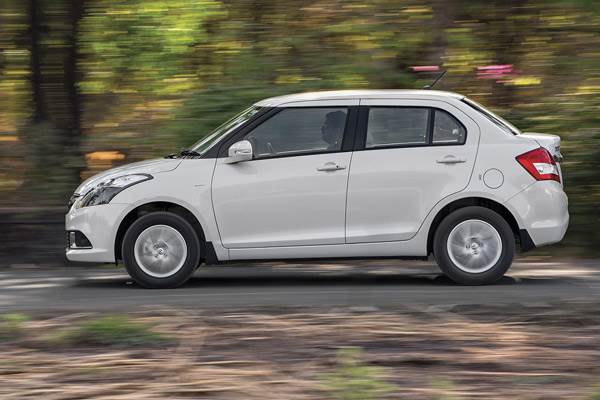
The Zest promises much at the outset. The gear selector is light, the engine responds nicely and there’s even a ‘Sport’ mode on this AMT gearbox. But it doesn’t crawl, so, when you take off, there’s a bit of a pause and a lurch, which makes you get off the accelerator, and that chops progress again. What also makes things difficult for the Tata is the fact that the engine, in this state of tune, also has a bit more turbo lag or delay. And this uneven progress takes some getting used to, be it in traffic or at parking speeds. The Zest is also not as nice to drive when you put your foot down. Yes, the surge is a bit stronger and that feels good, but the jerky throttle plays spoilsport again. Using Sport on the gearbox, though, make things much nicer. Gears are held on for longer, till 3200rpm, and this means there’s a lot more drive and performance. Of the two cars, it is also the Zest that is the slower performer. 0-100kph takes 15.78 secs, to the Dzire’s 13.8 secs, making it almost two seconds slower than the less powerful Maruti.
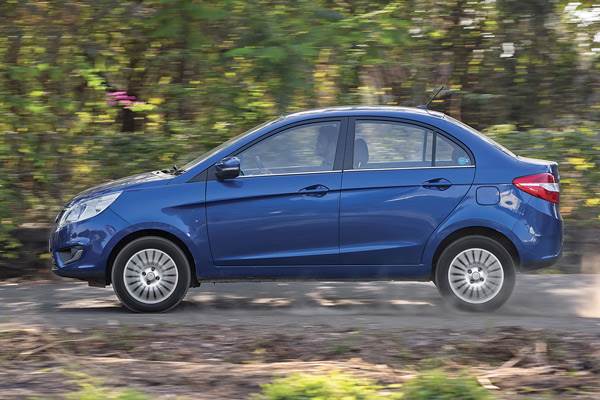
Apart from being quicker, the Maruti also scores over the Zest in the dynamics department. The Dzire turns in faster and sharper, with only a bit of body roll, which gives a driver the confidence to go quicker through corners. The steering is a bit heavier though, and there isn’t a good feeling at the centre-ahead position, which is annoying at slow speeds. Another niggle is that the Dzire feels a little stiff-kneed at lower speeds and sometimes it crashes through sharper potholes. However, pick up pace and it gets better, with quite good straight-line stability.
The Zest is the one with the lighter and more fluid steering. There’s a lightness that makes steering this car relatively effort free and the communication from the wheel stays impressive even as speeds rise. Stability in a straight line is a definite strength, and it even has the more absorbent and better ride of the two, soaking up even medium-sized bumps in silence and without too much deflection of the body.
What are theylike inside?
The Dzire’s interior feels airy. Maruti has used colour to good effect here. The top of the dashboard is black and the beige theme extends all across the door pads, seat covers and even the flooring. Design of the dashboard is simple and functional, the dials are easy to read too. You sit a bit low compared to the Zest, but the driving position is near-ideal. Storage space inside the cabin has been well thought of and is better than in the Zest.
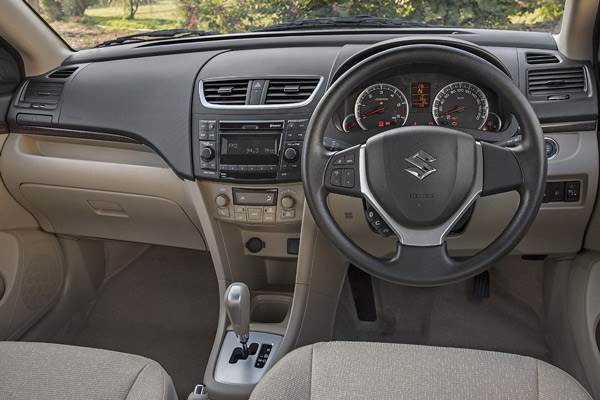
The music system is not as good as the Zest’s and although interior quality is decent, the design and layout of the dash looks a bit old now.
The Zest’s cabin is the better looking of the two. Be it the black and the beige strip on the dashboard, the nice looking dials, the useful MID display or the quality of materials. The Harman-developed music system has great tonal balance and feels the better of the two. Also, high-set seats are reasonably large and even large-sized passengers will find them comfy. There’s plenty of legroom and headroom even for the rear-seat passengers as well.
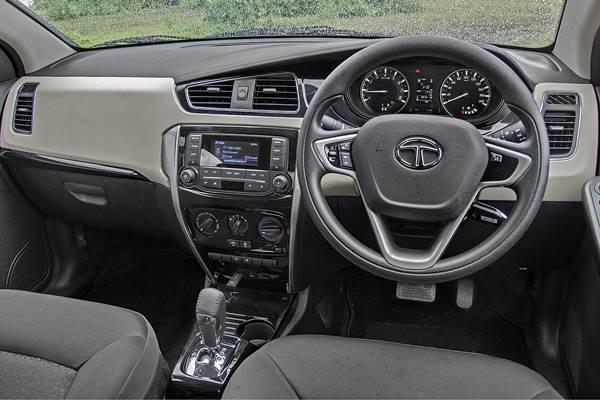
There’s even decent amount of storage space, but fitting a bottle in the front doors can be a task. Finding a good driving position is not as easy, however, with limited adjustments and tall seats. Also, the seat cushioning is a bit too soft which isn’t very comfortable. So, for the price, the Zest’s cabin feels much better.
Buying & owning
Maruti offers the Swift Dzire AMT in just a single variant – ZDi and it is priced at Rs 8.57 lakh before taxes in Delhi. Just like the Dzire diesel manual, warranty for the automatic is also a similar two years or 40,000km, whichever is earlier. In terms of sales and service network, Maruti is unrivalled and that’s a big advantage for buyers.
Unlike the Dzire, Tata offers the Zest AMT in two variants – XMA and ZTA. These two variants are priced at Rs 7.67 lakh to Rs 8.51 lakh before taxes in Delhi. In terms of warranty, the Zest has a standard warranty of three years or 1,00,000km. Now, it does offer a better warranty package but the Maruti has the advantage of a wider sales and service network.
Equipment & safety
The Tata Zest comes with features like projector headlamps, seat-height adjust for the driver seat, automatic climate control, a Harman touchscreen infotainment system with a rear-view camera, voice command and a gear-shift indicator.

The Zest's touchscreen infotainment system has good acoustics
The Dzire gets parking sensors instead of a reversing camera and is equipped with an auto-dimming internal rear-view mirror, whereas the Zest makes do with a manual unit. Both cars get Bluetooth telephony with steering-mounted audio controls, alloy wheels and outside rear-view mirrors (ORVMs) with turn Indicators.
In terms of safety, there’s driver and passenger airbags, anti-lock braking system (ABS) and electronic brake-force distribution (EBD) on both cars.
Verdict
The Tata Zest diesel auto is clearly a well-rounded package. It comes with one of the best cabins in its class, rides well, has a smooth, fluid steering and the fact that it is powered by a 89bhp version of Fiat’s 1.3 Multijet means performance is pretty solid. Yes, the automatic transmission is a bit jerky and that spoils the package a bit, but there’s no taking away from the fact that this is quite an accomplished car. Thing is, Maruti’s new Dzire AMT is a big step-up in terms of refinement and smoothness and this makes it much nicer to drive. In fact, so much better is this AMT, it offers an experience that’s closest to a conventional automatic. The car rides well, it’s easy to handle both in the city and on the highway and comfort levels on the front seats are extremely high. It isn’t as well equipped, it costs around Rs 13,000 more and space in the back is less, but the Maruti drives so much better, it’s almost an ‘automatic’ choice.


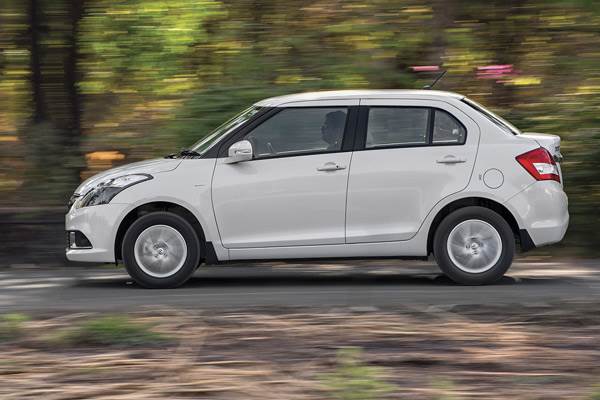
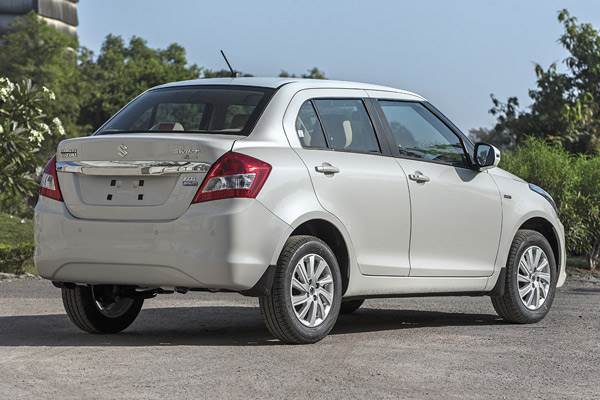


Comments
Member Login
Personal Details
No comments yet. Be the first to comment.